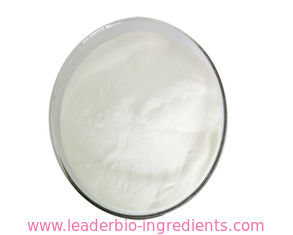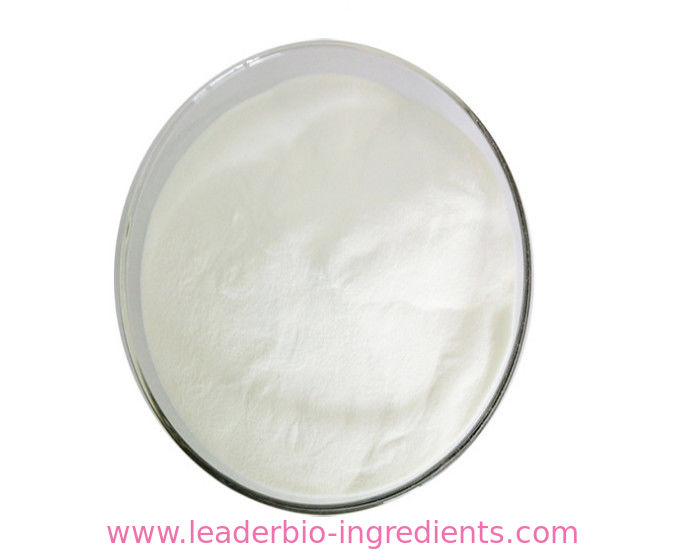| Product Name: |
Lactobionic acid |
| Synonyms: |
4-O-BETA-D-GALACTOPYRANOSYL-D-GLUCONIC ACID;LACTOBIONIC ACID;4-O-β-D-Galactopyranosyl-D-gluconic acid;LACTOBIONIC ACID FREE ACID;LACTOBIONIC ACID 97%;4-[β-D-Galactosido]-D-gluconic acid;Lactobionic Acid (mixture of Acid form and Lactone form);D-Gluconic acid, 4-O-.beta.-D-galactopyranosyl- |
| CAS: |
96-82-2 |
| MF: |
C12H22O12 |
| MW: |
358.3 |
| EINECS: |
202-538-3 |
| Product Categories: |
Biochemistry;Disaccharides;Sugar Acids;Sugars |
| Mol File: |
96-82-2.mol |
 |
| |
| Lactobionic acid Chemical Properties |
| Melting point |
113-118 °C(lit.) |
| alpha |
22.8 º (c=10, H2O) |
| Boiling point |
410.75°C (rough estimate) |
| density |
1.4662 (rough estimate) |
| refractive index |
26 ° (C=8.8, H2O) |
| solubility |
10 g/100 mL |
| pka |
3.28±0.35(Predicted) |
| form |
Powder |
| color |
White to Off-white |
| optical activity |
[α]20/D +25°, c = 10 in H2O |
| Water Solubility |
10 g/100 mL |
| Merck |
5342 |
| BRN |
95054 |
| CAS DataBase Reference |
96-82-2(CAS DataBase Reference) |
| |
| Lactobionic acid Usage And Synthesis |
| Description |
Lactobionic acid (C12H22O12) is a disaccharide obtained from the oxidation of lactose. Chemically, Lactobionic acid is made up of a galactose moiety that is bonded to a gluconic acid molecule through an r-like bond. The compound can be dehydrated to a lactone. Lactobionic acid is widely used in the chemical, food and pharmaceutical industries due to its chelating, emulsifying, humectant and chelating properties. Lactobionic acid and its constituent salts are essential as food additives due to excellent solubility, good taste, and health-promoting aspects. The compound may also be essential in the synthesis of targetable and biocompatible drug delivery systems. |
| Properties |
Lactobionic acid has a molecular weight of 358.296 g/mol and a monoisotopic mass of 358.111 g/mol, which is also its exact mass. The compound has a heavy atom count of 24.
Lactobionic acid has a melting point of 113-118°C and a boiling point of about 410.75°C. It is a white to off-white powder with a solubility of 10 g/100 mL in water and a density of about 1.4662. It is also slightly soluble in anhydrous methanol and ethanol.
Lactobionic acid is hygroscopic, and it has a good water retention potential hence its applicability to cosmetic products. The compound and its constituent mineral salts (Ca, Na, and K lactobionate) are produced commercially for medical and industrial applications and in some cases for research purposes. |
| Preparation |
The selective transformation of lactose into Lactobionic acid entails the oxidation of the radical aldehyde category of glucose on the lactose molecule to the carboxylic classification. The production of Lactobionic acid entails various processes which may include enzymatic synthesis, microbial production, biocatalytic oxidation, electrochemical oxidation and heterogeneous catalytic oxidation. |
| Extraction and Purification |
To enhance the productive capacity of Lactobionic acid, the enzymatic reaction can be cut off after several hours of activity and the unchanged substrates can be re-injected into the cycle after the elimination of useful products. The effective process of separation is through liquid chromatography particularly because the recovered species are pure.
Exposing the solution made of lactobionate ions through a sequence of ion-transfer resins produces a pure solution of Lactobionic acid with minimal amounts of calcium ions. Different techniques such as crystallization, evaporation, electrodialysis and ethanol precipitation can be employed to obtain Lactobionic acid. |
| Physiological & Commercial Applications |
Lactobionic acid is an essential compound based on its chelating properties and its ability to form complex bonds with Ca, Fe, Cu, and Mn. Its incorporation into food additives can stimulate mineral absorption and Ca2+ in the intestines hence enhancing one’s health.
Lactobionic acid is unaffected by digestive enzymes hence it is a valuable ingredient in the preparation of functional foods. It is poorly absorbed into the linings of the intestines hence it can also be a Bifidus booster molecule for functional beverages and foods.
It enhances the healing process of wounds hence it is valuable in oral, skin, nail, hair and vaginal mucosa care. As an antioxidant, Lactobionic acid acts by suppressing the synthesis of hydroxyl radicals due to its iron chelating ability.
As a food additive, Lactobionic acid functions as an acidifier in products containing fermented milk, an aging suppressor for bread, an antioxidant, and as a gelling or stabilizing medium in desserts.
In cosmetics, Lactobionic acid is applied as an active ingredient in regenerative and antiaging skin-care products based on its therapeutic properties. Its metal chelation potential suppresses the degeneration potential of metalloproteinase enzymes, which decreases the appearance of aging wrinkles.
In the chemical industry, Lactobionic acid is an active ingredient (sugar-based surfactant) in biodegradable detergents. It may also be used in drug delivery systems, nanoparticle diagnosis and tissue engineering. |
| Chemical Properties |
White to off-white crystalline powder |
| Uses |
Lactobionic acid is mainly used in preservation solutions for organ transplantation. It is used to produce erythromycine lactobionate. |
| Uses |
food additive |
| Uses |
Arginine metabolite in bovine brain; clonidine-displacing substance activity |
| Uses |
An inhibitor of matrix metalloproteinases |
| Definition |
ChEBI: A disaccharide formed between beta-D-galactose and D-gluconic acid. |
| Biotechnological Production |
Currently, lactobionic acid is produced by chemical synthesis using refined lactose as feedstock. This process is expensive due to the energy demand. Alternatively, Acidic Organic Compounds in Beverage, Food, and Feed Production 111 enzymatic processes have been suggested. For example, lactose could be reacted to lactobionic acid using an enzymatic system with co-factor regeneration. First, lactose is converted to lactobionolactone by a cellobiose dehydrogenase. This reaction requires an electron acceptor, which is regenerated by a laccase reducing oxygen to water. Finally, lactobionolactone spontaneously hydrolyzes to lactobionic acid.
Moreover, microbial production of lactobionic acid has been described. In a fed-batch cultivation of Burkolderia cepacia growing in a complex medium (lactose, salts, peptone, and yeast extract), a final titer of 400 g.L-1, a yield of approximately 1.0 g of lactobionic acid per gram of lactose, and a productivity of 1.67 g.L-1.h-1 have been achieved.
Another promising strategy for an inexpensive biotechnological process is the utilization of cheap raw materials. For example, lactobionic acid could be obtained from concentrated cheese whey by fermentation with Pseudomonas taetrolens. In a fed-batch process, a product concentration of 164 g.L-1 with a productivity of 2.05 g.L-1.h-1 and a yield of 0.82 g of lactobionic acid per gram of lactose have been observed. Furthermore, whole-cell biocatalysis using permeabilized Zymonmonas mobilis cells and an equimolar mixture of lactose and fructose has been tested. In a batch process, a maximum lactobionic acid concentration of 268 g.L-1 and a conversion rate of 72 % within 24 h have been measured. The productivity of lactobionic acid was 11.2 g.L-1.h-1 . |
| Clinical Use |
Erythromycin lactobionate is a salt with enhanced water solubility that is used for injections. |
| Purification Methods |
Crystallise lactobionic acid from water by addition of EtOH. [NMR: Taga et al. Bull Chem Soc Jpn 51 2278 1978, Beilstein 17 III/IV 3392, 17/7 V 436.] |
| |
| Lactobionic acid Preparation Products And Raw materials |
|

